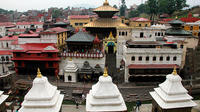Private Tour of Pashupatinath and Bouddhanath
Kathmandu, Nepal
Trip Type: Private Sightseeing Tours
Duration: 3 hours
This 3-hour private sightseeing tour of the World Heritage Sites in Kathmandu will give you an opportunity to witness the ancient art, culture and traditions of different time periods in Nepal. On this tour, you will learn about the different dynasties who ruled in Kathmandu. In addition, you will get to go to the sacred Hindu Temple Pashupatinath, and the Buddhist site Boudhanath Stupa.
More About This Activity All Private Sightseeing Tours →
This 3-hour private sightseeing tour of the World Heritage Sites in Kathmandu will give you an opportunity to witness the ancient art, culture and traditions of different time periods in Nepal. On this tour, you will learn about the different dynasties who ruled in Kathmandu. In addition, you will get to go to the sacred Hindu Temple Pashupatinath, and the Buddhist site Boudhanath Stupa.Your expert English-speaking tour guide will meet you at your hotel at 10:30am to take you for your 3-hour sightseeing tour of Kathmandu Valley that includes Boudhanath and Pashupatinath.
First stop is Pashupatinath. The sacred Hindu shrine Pashupatinath is located on the bank of the Bagmati river to the eastern side of Kathmandu. Believed to be built by Supuspa Deva, a Licchivi King, Pashupatinath was listed as a UNESCO World Heritage Site in 1979. The main temple of Pashupatinath was built using Pagoda style architecture with four main doors. The two levels of the roof are made of copper with a gold coating and they have a gold pinnacle. The inner sanctorum is the place where the main idol is placed, and the outer sanctorum is an open corridor like space. Though some of the buildings in the Pashupati area are damaged, the main building was untouched by the earthquake of April 25th, 2015 earthquake.
Then, head over to Boudhanath Stupa. Boudhanath is located on the northeastern outskirts of Kathmandu, is the largest stupa in the world and is a sacred site for Buddhist pilgrimages. Listed as a UNESCO World Heritage Site in 1979, Boudhanath is on the ancient trade route between Nepal and Tibet. The Stupa is said to entomb the remains of Kassapa Buddha. Founded by Licchivi King, Boudhanath has had minor damage caused by the earthquake on the 25th of April, 2015.
After that, your Kathmandu sightseeing tour ends and you will be transferred back to your hotel at 1:30pm.
First stop is Pashupatinath. The sacred Hindu shrine Pashupatinath is located on the bank of the Bagmati river to the eastern side of Kathmandu. Believed to be built by Supuspa Deva, a Licchivi King, Pashupatinath was listed as a UNESCO World Heritage Site in 1979. The main temple of Pashupatinath was built using Pagoda style architecture with four main doors. The two levels of the roof are made of copper with a gold coating and they have a gold pinnacle. The inner sanctorum is the place where the main idol is placed, and the outer sanctorum is an open corridor like space. Though some of the buildings in the Pashupati area are damaged, the main building was untouched by the earthquake of April 25th, 2015 earthquake.
Then, head over to Boudhanath Stupa. Boudhanath is located on the northeastern outskirts of Kathmandu, is the largest stupa in the world and is a sacred site for Buddhist pilgrimages. Listed as a UNESCO World Heritage Site in 1979, Boudhanath is on the ancient trade route between Nepal and Tibet. The Stupa is said to entomb the remains of Kassapa Buddha. Founded by Licchivi King, Boudhanath has had minor damage caused by the earthquake on the 25th of April, 2015.
After that, your Kathmandu sightseeing tour ends and you will be transferred back to your hotel at 1:30pm.
« Go Back

